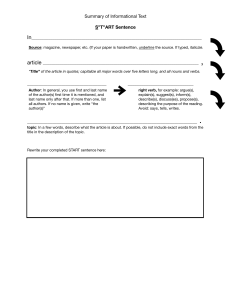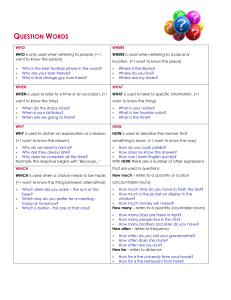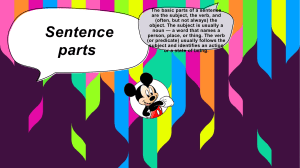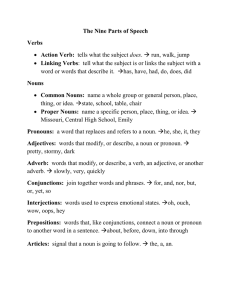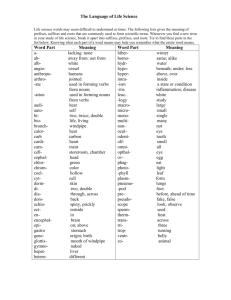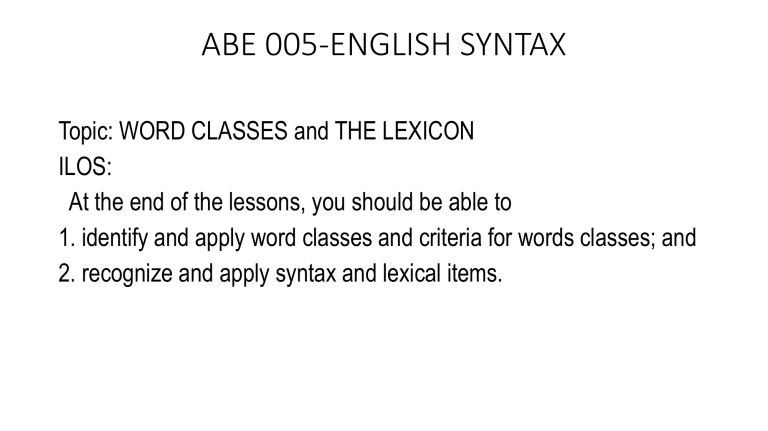
ABE 005-ENGLISH SYNTAX Topic: WORD CLASSES and THE LEXICON ILOS: At the end of the lessons, you should be able to 1. identify and apply word classes and criteria for words classes; and 2. recognize and apply syntax and lexical items. TOPIC - WORD CLASSES (Parts of Speech) The different classes of words – for example nouns, verbs, adjectives, adverbs, prepositions – were traditionally defined by what they denoted – people, places and things (nouns), actions (verbs) and properties (adjectives). Reliable definitions are based on formal criteria-morphological (does a given word take inflectional suffixes or is it invariable?), morpho-syntactic (does a given word take suffixes having to do with person and number, or with case?) and syntactic (where in a phrase or clause does a given word occur?). Once formal criteria have been set up, the connection between word classes and meaning can be studied. This bears not just on what a given word or class of words refers to but also on what speakers and writers do with it – refer, predicate or assert, modify. CRITERIA FOR WORD CLASSES Four types of criteria are employed to set up word classes: 1. Syntactic (of or according to syntax; ‘syntactic analysis’; is the set of rules that helps readers and writers make sense of sentences.) 2. Morphological (Morphology is the study of internal structure of words and forms a core part of linguistic study today.) 3. Morpho-syntactic (Involving both morphology and syntax. Number is a morphosyntactic unit; plurals require both a morphological change and syntactic agreement between noun and verb.) 4. Semantic (relating to meaning in language) Morphological and morpho-syntactic criteria have to do with what is called inflectional morphology. Consider the English examples "The tiger is smiling" and "The tigers are smiling". The contrast between tiger and tigers shows that tigers can be split into tiger and -s. Tiger is the stem and -s is the suffix added to the end of the stem. The stem tiger is a noun and the addition of -s does not affect this property. In contrast, the addition of -ish does affect it; tiger is a noun but tigerish is an adjective. In dictionaries of English, tigerish and tigers are treated differently. Tigerish is listed as a separate lexical item, that is, it might be listed in the same entry as tiger but appear in bold and with a short explanation of its meaning; tigers has no entry at all, since the makers of dictionaries assume that users will know how to convert the singular form of a given noun to a plural form. Suffixes such as -ish that derive new lexical items are derivational suffixes; suffixes that express grammatical information, such as ‘plural’, are inflectional suffixes. (The term comes from the Latin verb flectere ‘to bend’ and is connected with the idea that, in languages such as Russian with a multitude of inflectional suffixes, nouns, verbs and adjectives have a basic form that is bent by the addition of a suffix.) There is one more property of inflectional suffixes: in the tiger clauses above, tiger combines with "is smiling" and tigers combines with "are smiling". That is, there is linkage between subject noun and verb. Morphological criterion The singular form criterion is used in the heading because what is at stake is simply whether a given word allows grammatical suffixes or not. This criterion is the least important of the four listed above and is more relevant to some languages than others. It is of the greatest interest with respect to languages such as Russian, in which nouns have different suffixes (‘endings’ in the traditional, informal terminology) depending on their relationship to the verb. Examples are given in (1). (1) a. Sobaka lajala dog barked ‘The dog barked.’ b. Koshka tsarapala sobaku cat scratched dog ‘The cat scratched the dog.’ c. Petr dal sobake kost’ Peter gave dog bone ‘Peter gave the dog a bone.’ English does not have the same range of grammatical suffixes as Russian, but English nouns typically take a plural ending – fish–fishes, cat–cats and dog–dogs. (The -s represents different suffixes in speech – in cats it represents the initial sound of speed, in dogs the initial sound of zap.) Some nouns in English do not take a plural suffix – for example sheep, deer – and are said to be invariable. Morpho-syntactic criteria These criteria have to do with inflectional suffixes, as described above in connection with the tiger examples, and the information signaled by them. English does not have the rich system of inflections possessed by languages such as Russian, but English nouns do take suffixes expressing number (cat and cats, child and children and so on), and English verbs do take suffixes expressing tense: pull and pulls vs pulled. There are of course nouns, such as mouse–mice, that express number by other means, and there are verbs, such as write–wrote, eat–ate, that express tense by other means. Person is expressed only by the -s suffix added to verbs in the present tense – pulls, writes and so on. English adjectives are not associated with number or case, but many of them take suffixes signaling a greater quantity of some property (for example bigger) or the greatest quantity of some property (for example biggest). These morpho-syntactic properties of English words, signaling information about tense, person and number, are relevant to the recognition of different word classes. Syntactic criteria The syntactic criteria for word classes are based on what words a given word occurs with and the types of phrase in which a given word occurs. Syntactic criteria are the most important. All languages have syntax. The application of syntactic criteria is not straightforward. They can occur in various positions relative to the verb in a clause. Consider the English words that are called nouns. They all have several properties in common. Dog stole the turkey is unacceptable (assuming Dog is not a proper name), whereas Ethel stole the turkey is not. The difficulty is that the class of English nouns is a very large class of words that do not all behave in the same way. All nouns meet the criteria of occurring to the left of a verb in an active declarative clause, of occurring immediately to the right of a verb in an active declarative clause or of occurring to the right of a verb but preceded by a preposition. These are major criteria. A sufficiently detailed examination of the company kept by individual nouns would probably reveal that each noun has its own pattern of occurrence. Semantic criteria: what words mean There are no semantic criteria, aspects of the meaning of the different classes of words, that would enable us to decide whether any given word is a noun, adjective, verb, adverb or preposition-until they are used in the sentence. The traditional definition of nouns as words denoting people, places or things does not explain why words such as anger, idea or death are classified as nouns. Race the noun and race the verb both denote an event, as do the verb transmit in They transmitted the concert live and the noun transmission in The live transmission of the concert. The key move in the investigation of word classes is to accept that word classes must be defined on the basis of formal criteria – their morphological properties, their morpho-syntactic properties and their syntactic properties. Only when these formal patterns have been established can we move on to investigate the connection between meaning and word classes. Instructions: Take a look at the following passage and pick out eight adjectives and be ready to recite. Decrepit Victorian mansions loomed out of the snowfall on the town’s sporadic hills. Beyond them, cedars wove a steep mat of still green. The wind drove snowflakes steadily inland, hurling them against the fragrant trees, and the snow began to settle on the highest branches with a gentle implacability. Answer: (Adjectives) 1. Decrepit 2. Victorian 3. sporadic 4. steep 5. still 6. fragrant 7. highest 8. gentle Instructions: Pick out seven verbs in the following passage. By two o’clock on the first afternoon of the trial, snow covered all the island roads. A car pirouetted silently while skating on its tires, emerged from this on a transverse angle, and slid to a stop with one headlight thrust into the door of Petersen’s Grocery, which somebody opened at just the right moment – miraculously – so that no damage befell car or store. Answer: (Verbs) 1. covered 2. pirouetted 3. skating 4. emerged 5. slid 6. opened 7. befell THE LEXICON TOPIC - THE LEXICON (the vocabulary of a person, language or branch of knowledge.) Lexical items can be seen as playing an important and even controlling role. For instance, blame requires a noun phrase to its right, Emma blamed Harriet, and while it does not require a prepositional phrase it allows one and requires the preposition to be for – Emma blamed Harriet for the mistake. Some verbs, such as disappear, exclude any noun phrase to their right; *The magician disappeared the investment funds. Other verbs exclude entire constructions; resemble excludes the passive, and *Your friend is resembled by my brother is unacceptable. Faint requires an animate noun to its left, as in The patient fainted vs *The engine fainted, and persuade requires an animate noun to its right, as in We persuaded the students (to write their essays). Particular verbs require particular types of noun to their left or right. Verbs are said to select particular types of noun and to impose selectional restrictions. Verbs can be divided into subcategories with respect to the number and type of phrases they require, exclude or allow. The phenomenon is known as subcategorization, and verbs are said to subcategorise for particular types of constituents. There are three main categories of verbs: action verbs, helping verbs, and linking verbs. Action verb is a verb that describes an action, like run, jump, kick, eat, break, cry, smile, or think. A linking verb connects the subject with a word that gives information about the subject, such as a condition or relationship. Linking verbs include become, seem, and any form of the verb to be like am, is, are, was, were, and has been. Helping verb or modal verb- are verbs that help the main verb in a sentence by extending its meaning. It includes must, shall, will, should, would, can, could, may, and might. Take a look at the examples and analyze what properties distinguish modal verbs from ordinary verbs. The firm can deliver the documents to your house. 1.The firm can’t/cannot deliver the documents before Friday. Modal verbs combine directly with not 2. The firm delivers the documents to your house. The firm doesn’t/does not deliver the documents to your house. ordinary verbs require the support of do 3. Can the firm deliver the documents to my house? Modal verb is placed at the front of interrogative clauses Sources: Miller, Jim (2002). An Introduction to English Syntax. Great Britain: Edinburgh University Press Ltd. https://all-about-linguistics.group.shef.ac.uk/branches-oflinguistics/morphology/what-is-morphology/ https://www.lexico.com/definition/morphosyntactic

